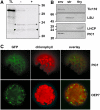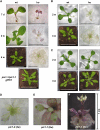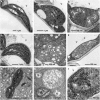PIC1, an ancient permease in Arabidopsis chloroplasts, mediates iron transport
- PMID: 17337631
- PMCID: PMC1867359
- DOI: 10.1105/tpc.106.047407
PIC1, an ancient permease in Arabidopsis chloroplasts, mediates iron transport
Abstract
In chloroplasts, the transition metals iron and copper play an essential role in photosynthetic electron transport and act as cofactors for superoxide dismutases. Iron is essential for chlorophyll biosynthesis, and ferritin clusters in plastids store iron during germination, development, and iron stress. Thus, plastidic homeostasis of transition metals, in particular of iron, is crucial for chloroplast as well as plant development. However, very little is known about iron uptake by chloroplasts. Arabidopsis thaliana PERMEASE IN CHLOROPLASTS1 (PIC1), identified in a screen for metal transporters in plastids, contains four predicted alpha-helices, is targeted to the inner envelope, and displays homology with cyanobacterial permease-like proteins. Knockout mutants of PIC1 grew only heterotrophically and were characterized by a chlorotic and dwarfish phenotype reminiscent of iron-deficient plants. Ultrastructural analysis of plastids revealed severely impaired chloroplast development and a striking increase in ferritin clusters. Besides upregulation of ferritin, pic1 mutants showed differential regulation of genes and proteins related to iron stress or transport, photosynthesis, and Fe-S cluster biogenesis. Furthermore, PIC1 and its cyanobacterial homolog mediated iron accumulation in an iron uptake-defective yeast mutant. These observations suggest that PIC1 functions in iron transport across the inner envelope of chloroplasts and hence in cellular metal homeostasis.
Figures









References
-
- Alonso, J.M., Stepanova, A.N., Leisse, T.J., Kim, C.J., Chen, H., Shinn, P., Stevenson, D.K., Zimmerman, J., Barajas, P., Cheuk, R., and Heller, C. (2003). Genome-wide insertional mutagenesis of Arabidopsis thaliana. Science 301 653–657. - PubMed
-
- Aronsson, H., and Jarvis, P. (2002). A simple method for isolating import-competent Arabidopsis chloroplasts. FEBS Lett. 529 215–220. - PubMed
-
- Asada, K. (1999). The water-water cycle in chloroplasts: Scavenging of active oxygen and dissipation of excess photons. Annu. Rev. Plant Physiol. Plant Mol. Biol. 50 601–639. - PubMed
Publication types
MeSH terms
Substances
Associated data
- Actions
- Actions
- Actions
- Actions
- Actions
- Actions
- Actions
- Actions
- Actions
- Actions
- Actions
LinkOut - more resources
Full Text Sources
Other Literature Sources
Medical
Molecular Biology Databases
Miscellaneous

